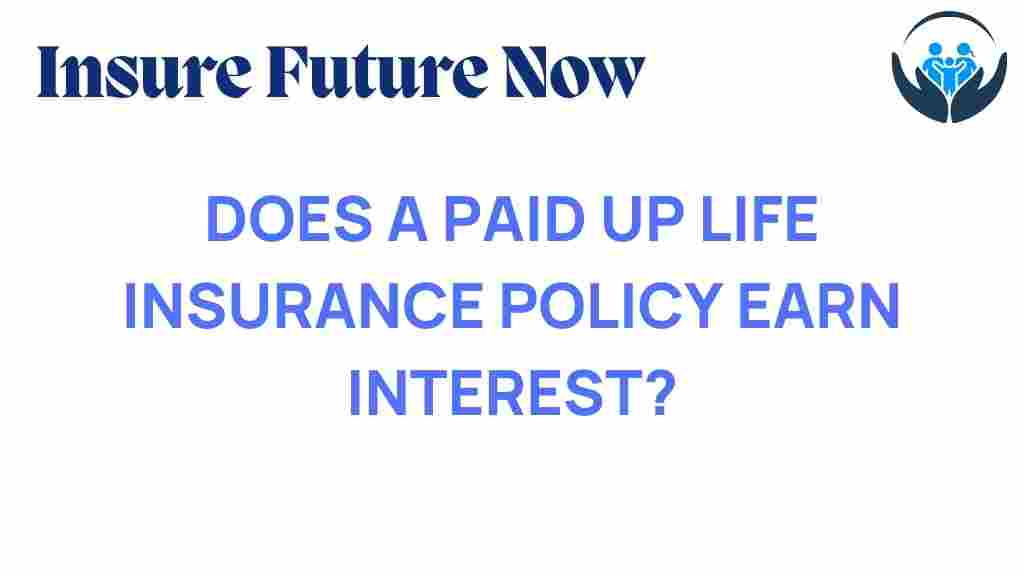Unraveling the Mystery: Does a Paid-Up Life Insurance Policy Earn Interest?
When considering financial planning, one may wonder about various insurance products and how they can fit into a broader investment strategy. Among these options is the concept of a paid-up life insurance policy. This type of policy often raises questions, especially regarding its ability to earn interest and provide policy benefits. In this article, we will delve into the nuances of paid-up life insurance, its cash value, and the potential returns it offers.
Understanding Paid-Up Life Insurance
A paid-up life insurance policy is a type of life insurance where the policyholder has paid all required premiums and the policy is now considered fully funded. This means that the policy remains in force without the need for further premium payments. The policyholder enjoys certain benefits, including:
- Lifetime coverage without future premium obligations.
- Potential cash value accumulation.
- Options for accessing the cash value through loans or withdrawals.
But does a paid-up life insurance policy actually earn interest? Let’s explore this further.
How Interest Works in Paid-Up Life Insurance Policies
Paid-up life insurance policies can accumulate cash value over time, and this cash value can earn interest. Here’s how it works:
- Permanent Life Insurance: Paid-up policies are often associated with permanent life insurance products, like whole life or universal life insurance, which have a cash value component.
- Interest Accumulation: The cash value typically earns interest based on the insurer’s declared rate or a formula specified in the policy. In some cases, this interest is guaranteed, while in others, it may vary based on investment performance.
- Dividends: Some whole life policies also pay dividends, which can be reinvested into the policy to increase cash value or taken as cash, effectively providing additional earnings.
Cash Value and Returns
When discussing returns on a paid-up life insurance policy, it’s important to understand the concept of cash value. Cash value is the amount of money that accumulates in a permanent life insurance policy, which the policyholder can access during their lifetime. Here’s how it functions:
- Accessing Cash Value: Policyholders can borrow against the cash value or withdraw funds, subject to tax implications. This can provide liquidity without needing to surrender the policy.
- Growth Potential: The cash value grows at a predetermined rate, offering a safe investment option compared to more volatile markets.
- Loan Interest: If you borrow against the cash value, the amount owed will accrue interest. If not repaid, it will reduce the death benefit.
Evaluating Policy Benefits
Before opting for a paid-up life insurance policy, it’s essential to consider the policy benefits and how they align with your overall financial strategy. Here are some key benefits:
- Financial Security: Provides a guaranteed death benefit for your beneficiaries, ensuring financial security.
- Tax Advantages: The cash value grows tax-deferred, and the death benefit is generally tax-free for beneficiaries.
- Stability: Unlike other investment options, paid-up life insurance offers stability and predictability.
Investing in Paid-Up Life Insurance
When considering investment options, paid-up life insurance can be a valuable component of a diversified portfolio. Here are some factors to consider:
- Long-Term Commitment: Life insurance is typically a long-term investment. Ensure that you are comfortable with the commitment.
- Policy Selection: Different policies offer varying interest rates and cash value growth. Research and compare options before deciding.
- Consult a Financial Advisor: It’s advisable to speak with a financial planner to determine how a paid-up life insurance policy fits into your overall financial plan.
Step-by-Step Process to Obtain a Paid-Up Life Insurance Policy
If you decide to pursue a paid-up life insurance policy, follow these steps:
- Step 1: Assess Your Financial Needs – Determine your financial goals, including coverage amount and how it fits into your financial planning.
- Step 2: Research Insurance Products – Explore various insurance products that offer paid-up options, such as whole life or universal life insurance.
- Step 3: Get Quotes – Request quotes from multiple insurers to compare premiums, benefits, and cash value growth.
- Step 4: Review Policy Details – Carefully read the policy document, focusing on the interest rates, cash value projections, and any fees.
- Step 5: Consult an Expert – Consider speaking with a financial advisor or insurance agent to clarify any doubts and finalize your decision.
- Step 6: Apply for the Policy – Complete the application process, which may include a medical exam and underwriting.
Troubleshooting Tips
As you navigate the world of paid-up life insurance, you may encounter some challenges. Here are troubleshooting tips to address common issues:
- Understanding Policy Terms: If the terms of your policy are confusing, don’t hesitate to ask your insurance agent for clarification.
- Interest Rate Changes: If you’re concerned about fluctuating interest rates, review your policy’s terms regarding rate guarantees and adjustments.
- Cash Value Accessibility: Know the procedures for accessing your cash value, including any potential fees or tax implications.
Conclusion
In conclusion, a paid-up life insurance policy can be an effective tool in your financial planning arsenal, offering both security and potential growth through cash value accumulation. While it does earn interest, the specific returns will depend on the policy type and insurer. Understanding the benefits, evaluating your options, and consulting with financial professionals will help you make informed decisions that align with your long-term financial goals. For more information on life insurance products and how they can fit into your financial strategy, check out this useful resource.
With the right knowledge and approach, paid-up life insurance can serve as a stable foundation for your financial future, providing both protection and investment potential.
For further reading on financial planning and investment options, explore this external link.
This article is in the category Coverage and created by InsureFutureNow Team
